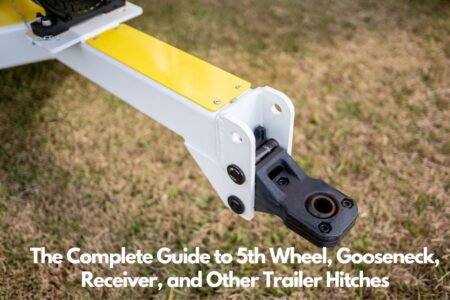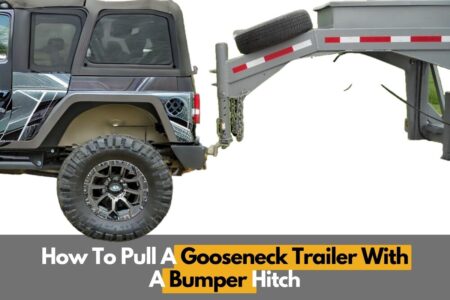
Too little tongue weight on a boat trailer causes instability and unsafe tow vehicle handling. Luckily there are several fixes to properly balance trailer loads and achieve the ideal 10-15% tongue weight.
Follow these troubleshooting steps to safely increase the tongue weight if your boat trailer has too little resting on the hitch:
Dangers of Too Little Tongue Weight
Insufficient tongue weight on a trailer leads to major issues:
- Trailer swaying – Side to side swaying motions begin at lower speeds.
- Reduced steering response – Tow vehicle is harder to steer precisely.
- Decreased braking power – The front wheels skid easily under heavy braking.
- “Tail wagging dog” – Trailer reactions control the tow vehicle’s motions.
- Rear wheel lifting – Weight imbalance causes the front to lift under acceleration.
- Rear tire overloading – The back tires carry too much weight.
- Hitch uncoupling – Trailer coupler can pop up off the ball hitch unexpectedly.
The consequences range from difficulty controlling the tow vehicle to catastrophic accidents. Fixing tongue weight prevents problems.
How Much Tongue Weight is Needed?
As a rule of thumb, optimal tongue weight is:
- 10-15% of loaded trailer weight for smaller trailers
- 12-15% of loaded weight for larger trailers
For example, a 5000 lb trailer should have 500-750 lbs of tongue weight.
Consult your trailer manual or loading sticker for the recommended target. Use a tongue weight scale to check your actual weight.
Adjusting Trailer Loads to Increase Tongue Weight
Shifting cargo rearward is the easiest way to add more weight onto the trailer tongue:
- Place heaviest items toward rear – bikes, engines, batteries, etc. Secure them safely.
- Remove weight from front – Only light items like PFDs, ropes, and empty bins up front.
- Balance cooler contents – Pack drinks toward cooler back so food weight offsets tongue.
- Slide mast back – Positioning the mast back increases tongue load.
- Empty water tank – Draining the fresh water tank removes weight off the front.
- Check fender clearance – Ensure adequate room between load and fenders to prevent rubbing.
- Weigh again – Confirm measurements are now within ideal tongue weight range.
Distributing weight properly prevents many trailer issues. Take time to load carefully.
Adjusting Hitch Height to Increase Tongue Weight
Another option is adjusting the coupler height relative to the trailer frame. This fine tunes tongue weight:
- Lower coupler and ball – Reduces tongue weight as more load goes to trailer axle.
- Raise coupler – Increases downward force on hitch, adding tongue weight.
- Adjust with shims – Use flat washers to shim the coupler higher as needed.
- Consider adjustable shank – A special adjustable hitch shank simplifies height changes.
- Keep coupler level – The tongue jack should sit as close to horizontal as possible.
- Re-measure after each change – Check tongue weight scale to see the effect.
Small coupler height changes make significant differences in balancing the tongue weight properly.
When to Add a Friction Sway Control
If the above adjustments still don’t provide enough tongue weight, adding a friction sway control may help:
- Press down on hitch head – The friction bars apply extra downward force on the hitch ball.
- Increase friction surface – Special sway control balls have a rough coating to grip better.
- Levels tow vehicle – Sway control keeps the tow vehicle riding more horizontally.
- Prevents trailer sway – Restricts sideways movements of the trailer.
Use an integrated weight distribution hitch with built-in sway control for maximum benefit. Watch demo videos to set it up properly.
When to Upgrade Your Hitch System
Upgrading the hitch itself becomes necessary if other fixes are still insufficient:
- Switch to weight distribution hitch – Load equalizing bars transfer weight forward from the axle to the tongue.
- Get heavier rating – Upgrade to a Class III or IV hitch rated for higher tongue capacities.
- Improve friction – Use a special moulded polymer hitch ball for increased grip.
- Add trailer brake controller – Electric or hydraulic brakes reduce strain on tow vehicle.
At the extreme, switching to a 5th wheel or gooseneck trailer that sits over the rear axle may be needed to achieve ideal weight balance.
Checking Your Work
After any adjustments or upgrades, always recheck:
- Tongue weight – Confirm you’ve reached the 10-15% target range with scales.
- Trailer level – Trailer frame and tow vehicle should sit evenly horizontal front to back.
- Tow vehicle ride – Suspension shouldn’t sag or compress with proper tongue weight.
- Hitch height – Adjustable shank slide should be as close to horizontal as possible.
- Tire load – No visual bulging or deformation from overload.
Taking time to properly balance trailer tongue weight makes towing much safer and easier. Don’t hesitate to get professional help achieving the right setup.
Frequently Asked Questions About Trailer Tongue Weight
Still have concerns about getting your trailer tongue weight corrected? Here are some common questions and answers:
How do I measure current tongue weight?
Use an inexpensive tongue weight scale. Hook it over the coupler and lift until the trailer tongue raises slightly.
What if the axle is too far forward?
You may need to relocate the axle father back under the trailer bed frame to allow sufficient tongue space.
Will deeper keel boats need more weight?
Yes, the keel weight may require sliding the trailer axle back or using heavy aft ballast in the boat.
How much can tongue weight affect trailer sway?
Insufficient weight can allow life-threatening sway to start at very low speeds. Get it corrected immediately.
How do I determine maximum hitch ratings?
Lookup your tow vehicle and hitch receiver class ratings maximum capacities. Stay within their limits for tongue weight.
Will a weight distribution hitch allow me to increase capacities?
No, a WD hitch only improves handling up the maximums. It does not increase the actual vehicle or hitch limits.
Achieving a safe percentage of weight on the trailer tongue makes all the difference in controlling your boat trailer. Take the time to adjust your load and hardware until you hit the right target weight.


